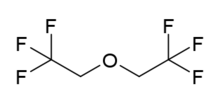Flurothyl
 |
|
| Clinical data | |
|---|---|
| ATC code |
|
| Identifiers | |
|
|
| Synonyms | Hexafluorodiethyl ether |
| CAS Number | |
| PubChem CID | |
| DrugBank | |
| ChemSpider | |
| UNII | |
| ECHA InfoCard | 100.155.160 |
| Chemical and physical data | |
| Formula | C4H4F6O |
| Molar mass | 182.064 |
| 3D model (Jmol) | |
| Density | 1.404 g/cm3 g/cm3 |
| Boiling point | 62 to 63 °C (144 to 145 °F) |
|
|
|
|
|
|
|
Flurothyl (Indoklon) is a volatile liquid drug from the halogenated ether family, related to inhaled anaesthetic agents such as diethyl ether, but having the opposite effects, acting as a stimulant and convulsant. A clear and stable liquid, it has a mild ethereal odor whose vapors are non-flammable. It is excreted from the body by the lungs in an unchanged state.
Several compounds related to the halogenated ether anesthetics have similar convulsant effects rather than producing sedation, and this has been helpful in studying the mechanism of action of these drugs.
The main current use of flurothyl is in scientific research for inducing seizures in laboratory animals.
Flurothyl was at one time studied in psychiatric medicine for shock therapy, in a similar manner to other convulsant drugs such as pentetrazol, as an alternative to electroconvulsive therapy (ECT). This use has now been discontinued.
In 1953, the Maryland pharmacologist J. C. Krantz experimented with flurothyl to induce seizures in psychiatric patients as an alternative to ECT. Flurothyl was injected into a plastic container in a tight fitting face mask. The patient inhaled a mixture of vapor and air, and expired air was forced into a charcoal adsorbent via a one-way valve. Oxygen was administered simultaneously. Flurothyl inhalations were first conducted without sedation or muscle paralysis. Premedication with pentothal and succinylcholine chloride, as is customary in ECT, was tested and found safe.
Four random assignment treatment studies found the clinical results for flurothyl to be as effective as those of ECT. Flurothyl treatments were administered on the same schedules as ECT. In some patients who had not responded to ECT, flurothyl treatment produced improvement.
The flurothyl treated patients showed less amnesia and confusion during the course of treatment with better patient acceptance. A detailed study comparing flurothyl and ECT in patients with severe endogenous depression, reported the degree of anterograde amnesia to be similar, but the degree of retrograde amnesia was much lower after flurothyl. Psychological tests showed memory impairments at the fourth week of treatment, and memory improvement two weeks after the last treatment, with no measurable differences between the treatments.
...
Wikipedia
